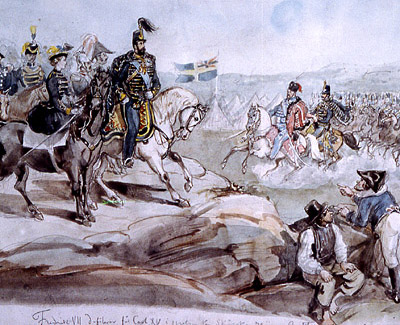| Unionstanker

| | Omkring 1850 var de kongelige på begge sider af Øresunds positivt stemt overfor skandinavismen og en ny nordisk union med fælles kongehus diskuteredes seriøst. Kongerne tog også velvilligt imod studenterskandinavisternes deputationer, men det kneb mere med opbakning til de dansk-tyske opgør i 1848 og 1864. |
Personalunion i sigte
Efter afsættelsen af den svenske konge Gustav IV Adolf, vælges en dansk prins Christian August til tronfølger, men efter hans bratte død indsættes en tidligere fransk general, Bernadotte på tronen. Bernadotte konverterer til den protestantiske tro på det svenske konsulat i Helsingør og sætter herefter over Sundet.
Enhedstankerne trivedes i 1850erne også ved det svenske og danske hof og førte der så langt at man diskuterede en personalunion under en svensk konge. Frederik d.7. var nemlig barnløs og det var da nærliggende med en fælles konge for Sverige, Norge og Danmark. Denne union ville så kunne spille en vigtigere rolle i europæisk storpolitik. Dette havde Europas stormagter givetvis også synspunkter på og man mente der at det danske monarkis integritet burde bevares. Dette blev fastslået på konferenser, som blev afholdt i London 1850 og 1852.
Ny dansk kongeslægt
Tronfølgen i Danmark flyttedes imidlertid over på prins Christian af Slesvig-Holstein-Sonderburg-Glücksburg og hans efterkommere. Måske var dette tidspunkt - med problemerne omkring Danmarks sydgrænse og den uklare arvefølge efter den barnløse Frederik d.7.- det afgørende for en mere omfattende skandinavisk samling, som for altid forpassedes med vedtagelsen af den danske tronfølgelov af 1852, hvorefter glücksburgeren Christian d. 9. skulle efterfølge Frederik d.7.
Mange danskere var imidlertid skeptiske overfor denne Christian som ny konge og at Frederik d.7. foretrak en svensk tronfølger frem for den danske Christian var helt åbenlyst. Både Oscar I og Frederik d.7. sigtede på en personalunion. En livlig propaganda gennemførtes i Europa for at få stormagterne til at anerkende en dynastisk forening imellem de nordiske lande. Mange (bl.a. Sturzen-Becker) skrev indlæg for at bearbejde den europæiske presse. Da Oscar I blev syg og døde i 1859, overtog sønnen Karl XV styret og unionsplanerne.
Gemytligt venskab
Personkemien imellem den nye svenske kong Karl XV og Frederik d.7. var endnu bedre. De træffedes flere gange, bl.a. på Ljungbyhed i Skåne 1860, i sammenhæng med studentermødet i København 1862, samt ved et stort møde i Skodsborg 1863 og samme år også på Bäckeskog i Skåne. En gemytlig venskab mellem de to konger opstod og forudsætningerne for en personalunion syntes gode. Karl var med sin folkelige stil desuden populær i både Danmark og Sverige. Han var også rundhåndet med sine løfter til danskerne og gav, i sammenhæng med mødet i Skodsborg, et mundtligt løfte om svensk militært støtte til Danmarks forsvar af dets sydgrænse, som nu på ny truedes af tyskerne.

Karl 15. og Frederik 7. | 
Karl 15. og Frederik 7. | 
Karl XVI i Helsingør | 
Fredensborg slotspark 1862 |
Brudte løfter
Dog, løfterne blev ikke indfriet da den dansk-tyske krig brød ud i 1863. I første omgang støttedes kongen af udenrigsminister Mandelstrøm og den svenske gesandt i København Hamilton, men blev senere underkendt af statsrådet. Den svenske regering meddelte at man ikke havde tænkt sig at sende tropper, en beslutning som gik stik imod med Karl XV: s ønsker. Midt i denne politiske turbulens døde Frederik d.7. og Christian 9. blev konge i Danmark. Unionstanken begyndte på grund af de svegne svenske løfter, den svenske regeringens mistro og den nye danske konges negative indstilling at svinde bort og skandinavismen mistede terræn. |